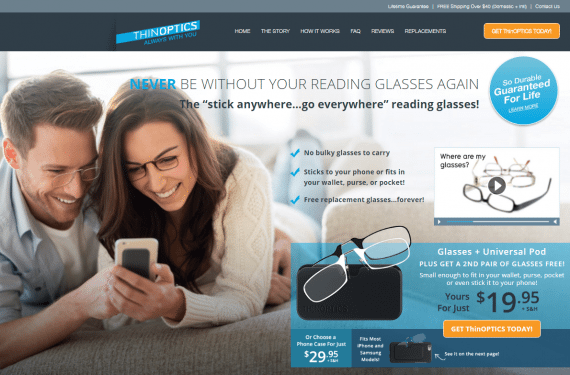More than half of Americans would rather shop online than in physical stores. For the younger crowd, that number is larger — up to 67 percent for consumers in their 20s and 30s. Those numbers alone are reason enough to consistently test and implement new features.
The online stores that really stand out are doing something differently. If they weren’t, they wouldn’t experience such loyalty.
For 2017, resolve to separate your ecommerce store from the crowd. Here are seven ideas to get you started.
7 Ways to Accelerate Your Online Store in 2017
Find your niche audience and show it lots of love. To be truly competitive, find your niche and stand out to the most important consumers. Sometimes this may narrow your primary target audience. Then again, loyal customers tend to send more shoppers via word of mouth advertising.
ThinOPTICS, which sells minimalistic reading glasses, showcases its uniquely designed products well. The store also runs a “pay it forward” program that allows customers to forward discounts to their friends and family. The result is a loyal following across the web.

ThinOPTICS provides a unique product. Its website focuses on just three important benefits to the glasses it sells. It also gives customers a unique discount code they can pass on to others.
Realize consumers increasingly use only smartphones, not computers. Omnichannel shopping is vital, but it should not be your only focus. More people are forgoing desktop computers — in 2015 nearly 15 percent of U.S. consumers said they rely solely on a smartphone for Internet access. That means mobile sites not only need to work fluidly with desktop versions, they also need to be able to stand on their own. The goal is focus on the broadest range of users, regardless of how they connect.
Give shoppers reasons to tap “checkout” on a smartphone. Despite the fact that smartphones and tablets account for nearly 60 percent of all ecommerce traffic, desktops still dominate actual sales transactions. People are still wary about making purchases on mobile devices. Nearly a third of users say they’re too concerned about privacy and security. Put them at ease by including appropriate text and logos in the mobile checkout.

This chart covering the second half of 2016 shows that desktop still rules when it comes to making final purchases. Forty-one percent of all sessions came from desktop users, but 63 percent of sales came from desktops. Top concerns on mobile are privacy and security. Source: Smart Insights.
By the way, the next reason for not purchasing on smartphones is the difficulty of shopping on mobile sites. Make a resolution to simplify mobile shopping.
Give them content they want (and can’t find elsewhere). Yes, you should generate and publish content your target audience expects to find at your site. But you should also produce articles, graphics, and videos that are not directly related to what you sell. If it’s content they won’t find anywhere else, all the better! Break out of the box with the content you publish. The worse that will happen is visitors won’t read it.

Blitsy, a craft store, alerts customers to upcoming crafting conventions. Some of its blog posts also focus on free printable crafts and journal pages.
Give them more ways to pay. With credit card and debit card theft making headlines, it’s important to address concerns, even if few customers have expressed them. Offering a “scan your card” option and allowing them to use stored data at checkout minimizes risk and speeds up the process. And, if you don’t accept PayPal and Amazon Payments, you’re behind the times. Listen to mobile consumers and offer simpler and more secure ways to pay. Stay abreast of the various payment options and implement new ones whenever you can.
Offer financial reasons to come back. Loyalty and rewards programs can play a big role in customer retention. For many, it’s hard to pass up earned “cash” that can be used on future purchases. Kohl’s is a good example. Several times a year it rewards customers with $10 Kohl’s Cash with every $50 spent. Of the ones who return to redeem the $10 voucher, many wind up buying well over that amount. That’s why so many consumers did much of their holiday shopping at this one retailer alone.

Kohl’s has built a die-hard following with its Kohl’s Cash promotions.
Provide an easy way to ask questions. Phone number, online chat, email, texting, social messaging: All are useful when conversing with shoppers. People want options. What’s easy for one may not be so simple for another. Give as many options as possible, and you’ll be ahead of most competitors.
Ecommerce trends are constantly changing. Fortunately, you don’t have to wait for someone else to come up with the big ideas, and you don’t have to wait for statistics to show you what you should be doing. Typically, by then, it’s already too late to stand out. Instead, listen to your gut and to your customers. It’s the two things that rarely steer you wrong.



